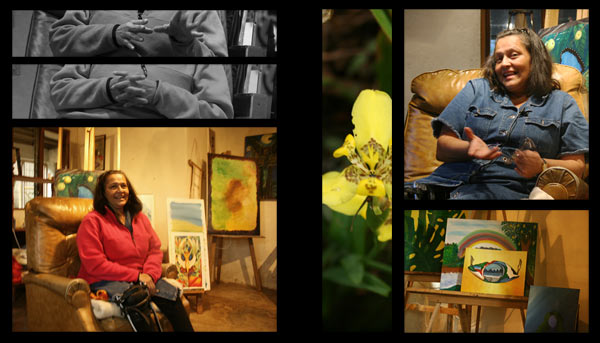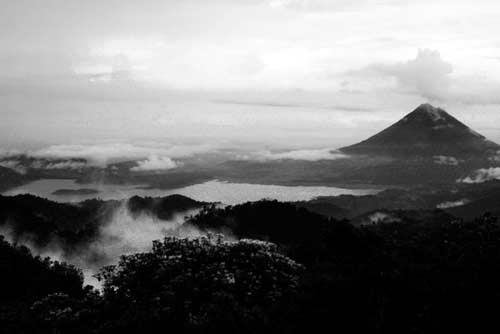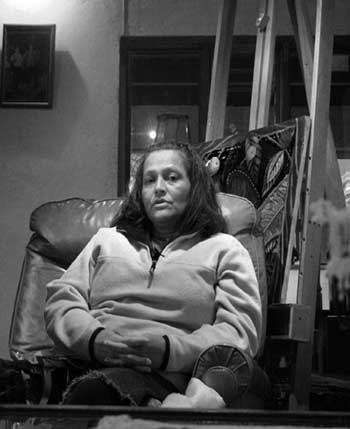Patricia Jiménez: Mujer Fuerte

Written by Lindsy R. Glick
“Soy Mujer del Siglo XXI—Conozco y Exijo Mis Derechos.”
This bumper sticker from the National Institution of Women in Costa Rica reads as follows, “I am a Woman of the Twenty-First Century—I Know and Demand my Rights.” It is pinned as the sole adornment on the door to Patricia Jiménez’s second-floor art studio. Her life is a true attestation of this simple stand for justice. She is a woman who empowers others, who explores new avenues of life and freedom—and shares them with others.
Patricia lives in a cozy, two-story house with a painting gallery below and an additional studio. One enters the house through the lower door after descending steps of stone, overgrown with moss and dripping with the afternoon’s cloud cover that slowly seeps into the spaces between trees. She is the type who always welcomes visitors con gusto, with much joy, into her home. The entrance is the painting gallery, which envelopes the room with colorful art: oil and watercolor paintings, illuminated by angled lights from the ceiling such as any gallery or museum might have. Some of the paintings are Patricia’s, but many are done or are works in progress by her friends.
 Patricia seats herself on the sofas squeezed between easels. She must sit slowly and carefully due to polio and the brace she wears on her right knee. Though she did not intend to have children, she gave birth to two sons. During her first pregnancy, she and her husband decided to move to Monteverde from San José. She didn’t want to live in the city where she would have to work and would not be able to stay at home to nurse and care for her son.Once in Monteverde, Patricia discovered a market for used clothing and proceeded to operate a store through her house to help make money. From her simple clothing store, her endeavors developed into a women’s art cooperative, CASEM, and now a painting group. No doubt there are a myriad of community projects with which she is involved but is too humble to tell all the stories, or simply lacks the time.
Patricia seats herself on the sofas squeezed between easels. She must sit slowly and carefully due to polio and the brace she wears on her right knee. Though she did not intend to have children, she gave birth to two sons. During her first pregnancy, she and her husband decided to move to Monteverde from San José. She didn’t want to live in the city where she would have to work and would not be able to stay at home to nurse and care for her son.Once in Monteverde, Patricia discovered a market for used clothing and proceeded to operate a store through her house to help make money. From her simple clothing store, her endeavors developed into a women’s art cooperative, CASEM, and now a painting group. No doubt there are a myriad of community projects with which she is involved but is too humble to tell all the stories, or simply lacks the time.
The idea for women to produce handicrafts came from a group of researchers examining a milk shortage. As they visited farms, they met women without any means to make money but with many needs. They didn’t have sufficient food for themselves or their children but had little idea how to change their situation while caring for their children and homes. Patricia and others encouraged the women to make crafts. They began copying and embroidering designs from a book of Costa Rican birds. Researchers and other visitors to the Monteverde Cloud Forest bought them as souvenirs to take back to their families and friends. In the mid-1990s, the women's work increased with the rise of tourism.
Though Patricia still participates in CASEM and assists the members, her new joy appears to be the painting group. Each Thursday a group of seven to fourteen women comes to her house to paint together. They give each other tips and sometimes receive instruction from visiting artists. It is a time when they can be together and create things. They always take a break to drink coffee, and, during this time, they are able to share their lives with each other.
 For some of the women, this weekly ritual is their source of strength and support, especially those suffering from domestic
violence. There is a saying in Costa Rica, “Luz por la calle, oscuro por la casa,” meaning, "It is light in the street, but dark in the home," and no one is to know or ask what happens within a family system. This view of the treatment of women is changing, and women like Patricia help to empower others and teach them their rights. She herself is divorced, which is notable, as it is uncommon for a woman to divorce her husband and consequently
be self-sufficient and happy in her own house.
Patricia is a powerful example to other women, though separation
is not always the encouraged action; ideally the root of the problem and the violence can be stopped.
For some of the women, this weekly ritual is their source of strength and support, especially those suffering from domestic
violence. There is a saying in Costa Rica, “Luz por la calle, oscuro por la casa,” meaning, "It is light in the street, but dark in the home," and no one is to know or ask what happens within a family system. This view of the treatment of women is changing, and women like Patricia help to empower others and teach them their rights. She herself is divorced, which is notable, as it is uncommon for a woman to divorce her husband and consequently
be self-sufficient and happy in her own house.
Patricia is a powerful example to other women, though separation
is not always the encouraged action; ideally the root of the problem and the violence can be stopped.
Patricia walks upstairs, maneuvering slowly but nimbly around the tight corners and narrow stairs. Her house was clearly not designed for a woman with a brace, but this is just another obstacle that Patricia conquers with ease. Her bedroom and upstairs studio emanate her personality: joyful, colorful, dedicated and full. She is compiling an album with old photos of Santa Elena and Monteverde from years ago when she first moved into the area. It also contains a pictorial history of the first women and work of CASEM to present-day town-life and CASEM’s beautiful gallery/shop along the main drive—bumpy and rustic though it still is. She has photos of paintings she has sold and also has a collection of recent poems, one of them her first ever composed in English. These vivid poems contain passionate images, real to life. “Semillas de Libertad” is carefully copied in gold lettering on a translucent page to accompany her newest painting with the same title. It is a painting and poem of birth, growth and life, recognizing the beauty and power of women.
Patricia’s incentives to continue working and helping others come from two things. The first is a desire and love for empowering people and working toward creative, sustainable solutions. “It is also partially,” she says, “because of the voice of an aunt that always tells me ‘Sin is not what you did wrong, but what you didn’t do.’” Her passion and care for others, though, is clearly the motivator that drives her beyond duty.
Women like Patricia are learning the new mantra of knowing and demanding their rights as human beings and women. They are throwing out the old “dicho,” or saying, of darkness in the house. They are bringing beauty, art and freedom into their homes for their children to see. They are strong women. They are mujeres fuertes.